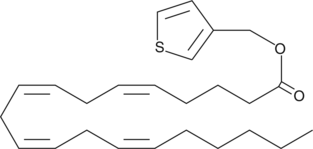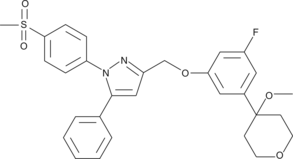Chemicals
Showing 13201–13350 of 41137 results
-
Caspofungin is an antifungal compound that is classified as an echinocandin, as it acts by noncompetititvely inhibiting the enzyme 1,3-β glucan synthase and preventing the synthesis of glucan in the fungal cell wall.{26520} It is effective against disseminated or invasive aspergillosis and candidiasis in mice.{26517,26521} Caspofungin has a 50% minimum effective concentration against Aspergillus spp. of 0.015 µg/ml.{26518} It does not antagonize other antifungal compounds, like amphotericin B, and, in some cases, may show additive or synergistic activity.{26520,26521,20805}
Brand:CaymanSKU:-Caspofungin is an antifungal compound that is classified as an echinocandin, as it acts by noncompetititvely inhibiting the enzyme 1,3-β glucan synthase and preventing the synthesis of glucan in the fungal cell wall.{26520} It is effective against disseminated or invasive aspergillosis and candidiasis in mice.{26517,26521} Caspofungin has a 50% minimum effective concentration against Aspergillus spp. of 0.015 µg/ml.{26518} It does not antagonize other antifungal compounds, like amphotericin B, and, in some cases, may show additive or synergistic activity.{26520,26521,20805}
Brand:CaymanSKU:-Caspofungin is an antifungal compound that is classified as an echinocandin, as it acts by noncompetititvely inhibiting the enzyme 1,3-β glucan synthase and preventing the synthesis of glucan in the fungal cell wall.{26520} It is effective against disseminated or invasive aspergillosis and candidiasis in mice.{26517,26521} Caspofungin has a 50% minimum effective concentration against Aspergillus spp. of 0.015 µg/ml.{26518} It does not antagonize other antifungal compounds, like amphotericin B, and, in some cases, may show additive or synergistic activity.{26520,26521,20805}
Brand:CaymanSKU:-Glucosidases catalyze the cleavage of individual glucosyl residues from various glycoconjugates, including complex carbohydrates and glycoproteins. Castanospermine is an inhibitor of both α- and β-glucosidases, inhibiting lysosomal and neutral α-glucosidases with Ki values of 0.1 and 10 μM, respectively, and lysosomal and cytosolic β-glucosidases with Ki values of 7 and 40 μM, respectively.{20414} It is effective both in vitro and in vivo.{20410,20409} Through its effects on glucosidases, castanospermine blocks N-linked glycosylation during post-translational modification of proteins, affecting protein trafficking and cell functions that are dependent on glycosylation, including angiogenesis.{20409,20411} Castanospermine also interferes with viral replication and infection that is dependent on glucosidase activity.{16269,20412,20413}
Brand:CaymanSKU:11313 - 10 mgAvailable on backorder
Glucosidases catalyze the cleavage of individual glucosyl residues from various glycoconjugates, including complex carbohydrates and glycoproteins. Castanospermine is an inhibitor of both α- and β-glucosidases, inhibiting lysosomal and neutral α-glucosidases with Ki values of 0.1 and 10 μM, respectively, and lysosomal and cytosolic β-glucosidases with Ki values of 7 and 40 μM, respectively.{20414} It is effective both in vitro and in vivo.{20410,20409} Through its effects on glucosidases, castanospermine blocks N-linked glycosylation during post-translational modification of proteins, affecting protein trafficking and cell functions that are dependent on glycosylation, including angiogenesis.{20409,20411} Castanospermine also interferes with viral replication and infection that is dependent on glucosidase activity.{16269,20412,20413}
Brand:CaymanSKU:11313 - 25 mgAvailable on backorder
Glucosidases catalyze the cleavage of individual glucosyl residues from various glycoconjugates, including complex carbohydrates and glycoproteins. Castanospermine is an inhibitor of both α- and β-glucosidases, inhibiting lysosomal and neutral α-glucosidases with Ki values of 0.1 and 10 μM, respectively, and lysosomal and cytosolic β-glucosidases with Ki values of 7 and 40 μM, respectively.{20414} It is effective both in vitro and in vivo.{20410,20409} Through its effects on glucosidases, castanospermine blocks N-linked glycosylation during post-translational modification of proteins, affecting protein trafficking and cell functions that are dependent on glycosylation, including angiogenesis.{20409,20411} Castanospermine also interferes with viral replication and infection that is dependent on glucosidase activity.{16269,20412,20413}
Brand:CaymanSKU:11313 - 5 mgAvailable on backorder
Casticin is a flavonol isolated from A. annua, V. trifolia, and V. agnus-castus that decreases proliferation in K562, HL-60, and Kasumi-1 leukemia cell lines (IC50s = 5.95, 4.82, and 15.56 µM, respectively).{38024} It blocks TGF-β/SMAD signaling in LX2 cells preventing activation, inhibiting proliferation, and inducing apoptosis of these hepatic stellate cells.{38025} In a mouse model of liver fibrosis, casticin (20 mg/kg) decreases TGF-β1 mRNA and phosphorylated SMAD (p-SMAD) levels. Casticin induces apoptosis in hepatocellular carcinoma (HCC) and breast cancer cells.{27628,27627} It also downregulates Twist and prevents the epithelial-mesenchymal transition (EMT) in human HCC SMMC-7721 cells.{27268}
Brand:CaymanSKU:-Out of stock
Casticin is a flavonol isolated from A. annua, V. trifolia, and V. agnus-castus that decreases proliferation in K562, HL-60, and Kasumi-1 leukemia cell lines (IC50s = 5.95, 4.82, and 15.56 µM, respectively).{38024} It blocks TGF-β/SMAD signaling in LX2 cells preventing activation, inhibiting proliferation, and inducing apoptosis of these hepatic stellate cells.{38025} In a mouse model of liver fibrosis, casticin (20 mg/kg) decreases TGF-β1 mRNA and phosphorylated SMAD (p-SMAD) levels. Casticin induces apoptosis in hepatocellular carcinoma (HCC) and breast cancer cells.{27628,27627} It also downregulates Twist and prevents the epithelial-mesenchymal transition (EMT) in human HCC SMMC-7721 cells.{27268}
Brand:CaymanSKU:-Out of stock
Catalpol is an iridoid glycoside that has been isolated from R. glutinosa and has diverse biological activities, including anti-apoptotic, pro-angiogenic, and radioprotective properties.{41802} It protects against mitochondrial pathway-dependent apoptosis in PC12 rat adrenal pheochromocytoma cells and H9c2 rat embryonic ventricular myocardial cells when used at a concentration of 10 µM.{41800,41801} Catalpol pretreatment reduces apoptosis and improves viability in AHH-1 human lymphocyte cells exposed to ionizing radiation and reduces intestinal damage induced by radiation in mice when used at concentrations and doses ranging from of 25 to 100 µg/ml and 25 to 100 mg/kg, respectively.{41799} In a rat model of stroke, catalpol (5 mg/kg, i.p.) increases the expression of erythropoietin and VEGF and improves angiogenesis in the brain.{41803}
Brand:CaymanSKU:24925 - 1 gAvailable on backorder
Catalpol is an iridoid glycoside that has been isolated from R. glutinosa and has diverse biological activities, including anti-apoptotic, pro-angiogenic, and radioprotective properties.{41802} It protects against mitochondrial pathway-dependent apoptosis in PC12 rat adrenal pheochromocytoma cells and H9c2 rat embryonic ventricular myocardial cells when used at a concentration of 10 µM.{41800,41801} Catalpol pretreatment reduces apoptosis and improves viability in AHH-1 human lymphocyte cells exposed to ionizing radiation and reduces intestinal damage induced by radiation in mice when used at concentrations and doses ranging from of 25 to 100 µg/ml and 25 to 100 mg/kg, respectively.{41799} In a rat model of stroke, catalpol (5 mg/kg, i.p.) increases the expression of erythropoietin and VEGF and improves angiogenesis in the brain.{41803}
Brand:CaymanSKU:24925 - 100 mgAvailable on backorder
Catalpol is an iridoid glycoside that has been isolated from R. glutinosa and has diverse biological activities, including anti-apoptotic, pro-angiogenic, and radioprotective properties.{41802} It protects against mitochondrial pathway-dependent apoptosis in PC12 rat adrenal pheochromocytoma cells and H9c2 rat embryonic ventricular myocardial cells when used at a concentration of 10 µM.{41800,41801} Catalpol pretreatment reduces apoptosis and improves viability in AHH-1 human lymphocyte cells exposed to ionizing radiation and reduces intestinal damage induced by radiation in mice when used at concentrations and doses ranging from of 25 to 100 µg/ml and 25 to 100 mg/kg, respectively.{41799} In a rat model of stroke, catalpol (5 mg/kg, i.p.) increases the expression of erythropoietin and VEGF and improves angiogenesis in the brain.{41803}
Brand:CaymanSKU:24925 - 250 mgAvailable on backorder
Catalpol is an iridoid glycoside that has been isolated from R. glutinosa and has diverse biological activities, including anti-apoptotic, pro-angiogenic, and radioprotective properties.{41802} It protects against mitochondrial pathway-dependent apoptosis in PC12 rat adrenal pheochromocytoma cells and H9c2 rat embryonic ventricular myocardial cells when used at a concentration of 10 µM.{41800,41801} Catalpol pretreatment reduces apoptosis and improves viability in AHH-1 human lymphocyte cells exposed to ionizing radiation and reduces intestinal damage induced by radiation in mice when used at concentrations and doses ranging from of 25 to 100 µg/ml and 25 to 100 mg/kg, respectively.{41799} In a rat model of stroke, catalpol (5 mg/kg, i.p.) increases the expression of erythropoietin and VEGF and improves angiogenesis in the brain.{41803}
Brand:CaymanSKU:24925 - 50 mgAvailable on backorder
Vinca alkaloids are an important class of cell cycle-dependent antimitotic agents. Catharanthine is a precursor of the vinblastine and vincristine group of alkaloids found in the Vinca plant, C. roseus that have been used widely in chemotherapy regimens.{22468} It is biologically active in synergy with similar indole alkaloids and can be used as starting material for the synthesis of vinblastine and vincristine.{22469,22467}
Brand:CaymanSKU:11695 - 100 mgAvailable on backorder
Vinca alkaloids are an important class of cell cycle-dependent antimitotic agents. Catharanthine is a precursor of the vinblastine and vincristine group of alkaloids found in the Vinca plant, C. roseus that have been used widely in chemotherapy regimens.{22468} It is biologically active in synergy with similar indole alkaloids and can be used as starting material for the synthesis of vinblastine and vincristine.{22469,22467}
Brand:CaymanSKU:11695 - 50 mgAvailable on backorder
Vinca alkaloids are an important class of cell cycle-dependent antimitotic agents. Catharanthine is a precursor of the vinblastine and vincristine group of alkaloids found in the Vinca plant, C. roseus that have been used widely in chemotherapy regimens.{22468} It is biologically active in synergy with similar indole alkaloids and can be used as starting material for the synthesis of vinblastine and vincristine.{22469,22467}
Brand:CaymanSKU:11695 - 500 mgAvailable on backorder
Cathepsin G inhibitor I is a potent and selective inhibitor of cathepsin G (IC50 = 53 nM).{25673} It weakly inhibits or has no effect on related proteases, including chymotrypsin, thrombin, plasmin, trypsin, tryptase, and elastase.{25673}
Brand:CaymanSKU:-Cathepsin G inhibitor I is a potent and selective inhibitor of cathepsin G (IC50 = 53 nM).{25673} It weakly inhibits or has no effect on related proteases, including chymotrypsin, thrombin, plasmin, trypsin, tryptase, and elastase.{25673}
Brand:CaymanSKU:-Cathepsin G inhibitor I is a potent and selective inhibitor of cathepsin G (IC50 = 53 nM).{25673} It weakly inhibits or has no effect on related proteases, including chymotrypsin, thrombin, plasmin, trypsin, tryptase, and elastase.{25673}
Brand:CaymanSKU:-Cathepsin L inhibitor is a potent inhibitor of cathepsin L (IC50 = 0.85 nM).{41143} It is selective for cathepsin L over calpain II and cathepsin B (IC50s = 184, and 85.1 nM, respectively). It is trypanocidal with an ED50 value of 45 nM against T. brucei that is well below the ED50 value of 21,500 nM for human HL-60 cells.{41145} Cathepsin L inhibitor completely suppresses osteoclastic pit formation on femur slices isolated from bovine cortical bone at a concentration of 1 μg/ml.{41143},{41144} In vivo, cathepsin L inhibitor (2.5-10 mg/kg) inhibits bone loss in a mouse model of osteoporosis in a dose-dependent manner.
Brand:CaymanSKU:23249 - 1 mgAvailable on backorder
Cathepsin L inhibitor is a potent inhibitor of cathepsin L (IC50 = 0.85 nM).{41143} It is selective for cathepsin L over calpain II and cathepsin B (IC50s = 184, and 85.1 nM, respectively). It is trypanocidal with an ED50 value of 45 nM against T. brucei that is well below the ED50 value of 21,500 nM for human HL-60 cells.{41145} Cathepsin L inhibitor completely suppresses osteoclastic pit formation on femur slices isolated from bovine cortical bone at a concentration of 1 μg/ml.{41143},{41144} In vivo, cathepsin L inhibitor (2.5-10 mg/kg) inhibits bone loss in a mouse model of osteoporosis in a dose-dependent manner.
Brand:CaymanSKU:23249 - 10 mgAvailable on backorder
Cathepsin L inhibitor is a potent inhibitor of cathepsin L (IC50 = 0.85 nM).{41143} It is selective for cathepsin L over calpain II and cathepsin B (IC50s = 184, and 85.1 nM, respectively). It is trypanocidal with an ED50 value of 45 nM against T. brucei that is well below the ED50 value of 21,500 nM for human HL-60 cells.{41145} Cathepsin L inhibitor completely suppresses osteoclastic pit formation on femur slices isolated from bovine cortical bone at a concentration of 1 μg/ml.{41143},{41144} In vivo, cathepsin L inhibitor (2.5-10 mg/kg) inhibits bone loss in a mouse model of osteoporosis in a dose-dependent manner.
Brand:CaymanSKU:23249 - 25 mgAvailable on backorder
Cathepsin L inhibitor is a potent inhibitor of cathepsin L (IC50 = 0.85 nM).{41143} It is selective for cathepsin L over calpain II and cathepsin B (IC50s = 184, and 85.1 nM, respectively). It is trypanocidal with an ED50 value of 45 nM against T. brucei that is well below the ED50 value of 21,500 nM for human HL-60 cells.{41145} Cathepsin L inhibitor completely suppresses osteoclastic pit formation on femur slices isolated from bovine cortical bone at a concentration of 1 μg/ml.{41143},{41144} In vivo, cathepsin L inhibitor (2.5-10 mg/kg) inhibits bone loss in a mouse model of osteoporosis in a dose-dependent manner.
Brand:CaymanSKU:23249 - 5 mgAvailable on backorder
Prostaglandins are rapidly inactivated in vivo by the action of 15-hydroxy prostaglandin dehydrogenase (15-hydroxy PGDH). This enzyme oxidizes the 15-hydroxyl group and hydrogenates the 13,14-double bond, producing 13,14-dihydro-15 keto metabolites with greatly reduced biological activity. CAY10397 is a selective inhibitor of 15-hydroxy PGDH with an IC50 of approximately 10 µM.{8455} CAY10397 acts to prolong the lifetime and activity of endogenously produced prostaglandins both in cell culture and in vivo.
Brand:CaymanSKU:70130 - 1 mgAvailable on backorder
Prostaglandins are rapidly inactivated in vivo by the action of 15-hydroxy prostaglandin dehydrogenase (15-hydroxy PGDH). This enzyme oxidizes the 15-hydroxyl group and hydrogenates the 13,14-double bond, producing 13,14-dihydro-15 keto metabolites with greatly reduced biological activity. CAY10397 is a selective inhibitor of 15-hydroxy PGDH with an IC50 of approximately 10 µM.{8455} CAY10397 acts to prolong the lifetime and activity of endogenously produced prostaglandins both in cell culture and in vivo.
Brand:CaymanSKU:70130 - 10 mgAvailable on backorder
Prostaglandins are rapidly inactivated in vivo by the action of 15-hydroxy prostaglandin dehydrogenase (15-hydroxy PGDH). This enzyme oxidizes the 15-hydroxyl group and hydrogenates the 13,14-double bond, producing 13,14-dihydro-15 keto metabolites with greatly reduced biological activity. CAY10397 is a selective inhibitor of 15-hydroxy PGDH with an IC50 of approximately 10 µM.{8455} CAY10397 acts to prolong the lifetime and activity of endogenously produced prostaglandins both in cell culture and in vivo.
Brand:CaymanSKU:70130 - 25 mgAvailable on backorder
Prostaglandins are rapidly inactivated in vivo by the action of 15-hydroxy prostaglandin dehydrogenase (15-hydroxy PGDH). This enzyme oxidizes the 15-hydroxyl group and hydrogenates the 13,14-double bond, producing 13,14-dihydro-15 keto metabolites with greatly reduced biological activity. CAY10397 is a selective inhibitor of 15-hydroxy PGDH with an IC50 of approximately 10 µM.{8455} CAY10397 acts to prolong the lifetime and activity of endogenously produced prostaglandins both in cell culture and in vivo.
Brand:CaymanSKU:70130 - 5 mgAvailable on backorder
CAY10398 is an inhibitor of histone deacetylase (HDAC1) with an IC50 value of 10 µM.{8714} Similar potency is observed with trapoxin A and B, whereas trichostatin A is more potent inhibitor of the enzyme. Trichostatin A also selectively inhibits the removal of acetyl groups from the amino-terminal lysine residues of core histones, which modulates the access of transcription factors to the underlying genomic DNA.{4011} However, trichostatin A is much more expensive than CAY10398. CAY10398 thus represents a selective and cost-effective compound for the inhibition of HDAC.
Brand:CaymanSKU:89740 - 1 mgAvailable on backorder
CAY10398 is an inhibitor of histone deacetylase (HDAC1) with an IC50 value of 10 µM.{8714} Similar potency is observed with trapoxin A and B, whereas trichostatin A is more potent inhibitor of the enzyme. Trichostatin A also selectively inhibits the removal of acetyl groups from the amino-terminal lysine residues of core histones, which modulates the access of transcription factors to the underlying genomic DNA.{4011} However, trichostatin A is much more expensive than CAY10398. CAY10398 thus represents a selective and cost-effective compound for the inhibition of HDAC.
Brand:CaymanSKU:89740 - 10 mgAvailable on backorder
CAY10398 is an inhibitor of histone deacetylase (HDAC1) with an IC50 value of 10 µM.{8714} Similar potency is observed with trapoxin A and B, whereas trichostatin A is more potent inhibitor of the enzyme. Trichostatin A also selectively inhibits the removal of acetyl groups from the amino-terminal lysine residues of core histones, which modulates the access of transcription factors to the underlying genomic DNA.{4011} However, trichostatin A is much more expensive than CAY10398. CAY10398 thus represents a selective and cost-effective compound for the inhibition of HDAC.
Brand:CaymanSKU:89740 - 25 mgAvailable on backorder
CAY10398 is an inhibitor of histone deacetylase (HDAC1) with an IC50 value of 10 µM.{8714} Similar potency is observed with trapoxin A and B, whereas trichostatin A is more potent inhibitor of the enzyme. Trichostatin A also selectively inhibits the removal of acetyl groups from the amino-terminal lysine residues of core histones, which modulates the access of transcription factors to the underlying genomic DNA.{4011} However, trichostatin A is much more expensive than CAY10398. CAY10398 thus represents a selective and cost-effective compound for the inhibition of HDAC.
Brand:CaymanSKU:89740 - 5 mgAvailable on backorder
Fatty acid amide hydrolase (FAAH) is the enzyme responsible for hydrolysis and inactivation of fatty acid amides including anandamide and oleamide. CAY10401 is a selective, potent inhibitor of rat FAAH exhibiting a Ki value of 0.14 nM.{8481} CAY10401 is approximately 580 fold more potent than oleyl trifluoromethyl ketone when assayed under the same conditions.{8481}
Brand:CaymanSKU:71652 - 1 mgAvailable on backorder
Fatty acid amide hydrolase (FAAH) is the enzyme responsible for hydrolysis and inactivation of fatty acid amides including anandamide and oleamide. CAY10401 is a selective, potent inhibitor of rat FAAH exhibiting a Ki value of 0.14 nM.{8481} CAY10401 is approximately 580 fold more potent than oleyl trifluoromethyl ketone when assayed under the same conditions.{8481}
Brand:CaymanSKU:71652 - 100 µgAvailable on backorder
Fatty acid amide hydrolase (FAAH) is the enzyme responsible for hydrolysis and inactivation of fatty acid amides including anandamide and oleamide. CAY10401 is a selective, potent inhibitor of rat FAAH exhibiting a Ki value of 0.14 nM.{8481} CAY10401 is approximately 580 fold more potent than oleyl trifluoromethyl ketone when assayed under the same conditions.{8481}
Brand:CaymanSKU:71652 - 5 mgAvailable on backorder
Fatty acid amide hydrolase (FAAH) is the enzyme responsible for hydrolysis and inactivation of fatty acid amides including anandamide and oleamide. CAY10401 is a selective, potent inhibitor of rat FAAH exhibiting a Ki value of 0.14 nM.{8481} CAY10401 is approximately 580 fold more potent than oleyl trifluoromethyl ketone when assayed under the same conditions.{8481}
Brand:CaymanSKU:71652 - 500 µgAvailable on backorder
Many non-steroidal anti-inflammatory drugs (NSAIDs) are potent but non-selective inhibitors of both COX-1 and COX-2 in humans.{1286} CAY10404 is one of the most selective inhibitors of COX-2 which has been reported to date, with a selectivity index (SI; SI = IC50 COX-1/IC50 COX-2) of >500,000. (The COX-1 IC50 is >500 mM, and COX-2 IC50 is 2 inhibitors, and is comparable to the SI of second generation selective COX-2 inhibitors, such as valdecoxib and etoricoxib.{8926}
Brand:CaymanSKU:70210 - 1 mgAvailable on backorder
Many non-steroidal anti-inflammatory drugs (NSAIDs) are potent but non-selective inhibitors of both COX-1 and COX-2 in humans.{1286} CAY10404 is one of the most selective inhibitors of COX-2 which has been reported to date, with a selectivity index (SI; SI = IC50 COX-1/IC50 COX-2) of >500,000. (The COX-1 IC50 is >500 mM, and COX-2 IC50 is 2 inhibitors, and is comparable to the SI of second generation selective COX-2 inhibitors, such as valdecoxib and etoricoxib.{8926}
Brand:CaymanSKU:70210 - 10 mgAvailable on backorder
Many non-steroidal anti-inflammatory drugs (NSAIDs) are potent but non-selective inhibitors of both COX-1 and COX-2 in humans.{1286} CAY10404 is one of the most selective inhibitors of COX-2 which has been reported to date, with a selectivity index (SI; SI = IC50 COX-1/IC50 COX-2) of >500,000. (The COX-1 IC50 is >500 mM, and COX-2 IC50 is 2 inhibitors, and is comparable to the SI of second generation selective COX-2 inhibitors, such as valdecoxib and etoricoxib.{8926}
Brand:CaymanSKU:70210 - 5 mgAvailable on backorder
Many non-steroidal anti-inflammatory drugs (NSAIDs) are potent but non-selective inhibitors of both COX-1 and COX-2 in humans.{1286} CAY10404 is one of the most selective inhibitors of COX-2 which has been reported to date, with a selectivity index (SI; SI = IC50 COX-1/IC50 COX-2) of >500,000. (The COX-1 IC50 is >500 mM, and COX-2 IC50 is 2 inhibitors, and is comparable to the SI of second generation selective COX-2 inhibitors, such as valdecoxib and etoricoxib.{8926}
Brand:CaymanSKU:70210 - 50 mgAvailable on backorder
CAY10406 is a trifluoromethyl analog of an isatin sulfonamide compound that selectively inhibits caspases 3 and 7.{8929} The non-trifluoromethyl compound exhibits Ki values of 1.2 nM and 6 nM for caspases 3 and 7, respectively. For all of the other caspases tested, it is 100 to 1,000 times less potent. Caspases 3 and 7 are ‘effector caspases’ that are downstream from the initiating steps of apoptosis, and are implicated in the main proteolytic processing of the apoptotic signal. No data is currently available for caspase inhibition by CAY10406.
Brand:CaymanSKU:72510 - 1 mgAvailable on backorder
CAY10406 is a trifluoromethyl analog of an isatin sulfonamide compound that selectively inhibits caspases 3 and 7.{8929} The non-trifluoromethyl compound exhibits Ki values of 1.2 nM and 6 nM for caspases 3 and 7, respectively. For all of the other caspases tested, it is 100 to 1,000 times less potent. Caspases 3 and 7 are ‘effector caspases’ that are downstream from the initiating steps of apoptosis, and are implicated in the main proteolytic processing of the apoptotic signal. No data is currently available for caspase inhibition by CAY10406.
Brand:CaymanSKU:72510 - 10 mgAvailable on backorder
CAY10406 is a trifluoromethyl analog of an isatin sulfonamide compound that selectively inhibits caspases 3 and 7.{8929} The non-trifluoromethyl compound exhibits Ki values of 1.2 nM and 6 nM for caspases 3 and 7, respectively. For all of the other caspases tested, it is 100 to 1,000 times less potent. Caspases 3 and 7 are ‘effector caspases’ that are downstream from the initiating steps of apoptosis, and are implicated in the main proteolytic processing of the apoptotic signal. No data is currently available for caspase inhibition by CAY10406.
Brand:CaymanSKU:72510 - 100 mgAvailable on backorder
CAY10406 is a trifluoromethyl analog of an isatin sulfonamide compound that selectively inhibits caspases 3 and 7.{8929} The non-trifluoromethyl compound exhibits Ki values of 1.2 nM and 6 nM for caspases 3 and 7, respectively. For all of the other caspases tested, it is 100 to 1,000 times less potent. Caspases 3 and 7 are ‘effector caspases’ that are downstream from the initiating steps of apoptosis, and are implicated in the main proteolytic processing of the apoptotic signal. No data is currently available for caspase inhibition by CAY10406.
Brand:CaymanSKU:72510 - 5 mgAvailable on backorder
Butaprost is a structural analog of prostaglandin E2 (PGE2) with good selectivity for the EP2 receptor subtype. Butaprost binds with about 1/10 the affinity of PGE2 to the recombinant murine EP2 receptor, and does not bind appreciably to any of the other murine EP receptors or DP, TP, FP, or IP receptors.{6640} CAY10408 is a free acid, 2-series analog of butaprost. It is the less active C-16 epimer compared to the 16(S) isomer, which has the same stereochemistry as butaprost. Butaprost has frequently been used to pharmacologically define the EP receptor expression profile of various human and animal tissues and cells.{3317} Since the majority of reports related to butaprost utilize the methyl ester derivative,{3178,1752} it may be some time before the precise pharmacology of the free acid compounds, like CAY10408, is reported.
Brand:CaymanSKU:-Butaprost is a structural analog of prostaglandin E2 (PGE2) with good selectivity for the EP2 receptor subtype. Butaprost binds with about 1/10 the affinity of PGE2 to the recombinant murine EP2 receptor, and does not bind appreciably to any of the other murine EP receptors or DP, TP, FP, or IP receptors.{6640} CAY10408 is a free acid, 2-series analog of butaprost. It is the less active C-16 epimer compared to the 16(S) isomer, which has the same stereochemistry as butaprost. Butaprost has frequently been used to pharmacologically define the EP receptor expression profile of various human and animal tissues and cells.{3317} Since the majority of reports related to butaprost utilize the methyl ester derivative,{3178,1752} it may be some time before the precise pharmacology of the free acid compounds, like CAY10408, is reported.
Brand:CaymanSKU:-Butaprost is a structural analog of prostaglandin E2 (PGE2) with good selectivity for the EP2 receptor subtype. Butaprost binds with about 1/10 the affinity of PGE2 to the recombinant murine EP2 receptor, and does not bind appreciably to any of the other murine EP receptors or DP, TP, FP, or IP receptors.{6640} CAY10408 is a free acid, 2-series analog of butaprost. It is the less active C-16 epimer compared to the 16(S) isomer, which has the same stereochemistry as butaprost. Butaprost has frequently been used to pharmacologically define the EP receptor expression profile of various human and animal tissues and cells.{3317} Since the majority of reports related to butaprost utilize the methyl ester derivative,{3178,1752} it may be some time before the precise pharmacology of the free acid compounds, like CAY10408, is reported.
Brand:CaymanSKU:-CAY10410 is an analog of prostaglandin D2/prostaglandin J2 (PGD2/PGJ2) with structural modifications intended to give it PPARγ ligand activity and resistance to metabolism. 15-deoxy-Δ12,14-PGJ2 has been shown to be a potent ligand for PPARγ.{1424} Metabolism of the cyclopentenone prostaglandins PGA2, PGJ2, and Δ12-PGJ2 occurs via glutathione addition across the α,β unsaturated enone.{7193} CAY10410 was designed as an analog of the PPARγ-binding prostaglandins which could not undergo this conjugation reaction. In human neuroblastoma SH-SY5Y cells, CAY10410 was not cytotoxic at up to 25 µM. It also failed to covalently modify thioredoxin or induce oxidative stress at 50 µM.{12676}
Brand:CaymanSKU:-Available on backorder
CAY10410 is an analog of prostaglandin D2/prostaglandin J2 (PGD2/PGJ2) with structural modifications intended to give it PPARγ ligand activity and resistance to metabolism. 15-deoxy-Δ12,14-PGJ2 has been shown to be a potent ligand for PPARγ.{1424} Metabolism of the cyclopentenone prostaglandins PGA2, PGJ2, and Δ12-PGJ2 occurs via glutathione addition across the α,β unsaturated enone.{7193} CAY10410 was designed as an analog of the PPARγ-binding prostaglandins which could not undergo this conjugation reaction. In human neuroblastoma SH-SY5Y cells, CAY10410 was not cytotoxic at up to 25 µM. It also failed to covalently modify thioredoxin or induce oxidative stress at 50 µM.{12676}
Brand:CaymanSKU:-Available on backorder
CAY10410 is an analog of prostaglandin D2/prostaglandin J2 (PGD2/PGJ2) with structural modifications intended to give it PPARγ ligand activity and resistance to metabolism. 15-deoxy-Δ12,14-PGJ2 has been shown to be a potent ligand for PPARγ.{1424} Metabolism of the cyclopentenone prostaglandins PGA2, PGJ2, and Δ12-PGJ2 occurs via glutathione addition across the α,β unsaturated enone.{7193} CAY10410 was designed as an analog of the PPARγ-binding prostaglandins which could not undergo this conjugation reaction. In human neuroblastoma SH-SY5Y cells, CAY10410 was not cytotoxic at up to 25 µM. It also failed to covalently modify thioredoxin or induce oxidative stress at 50 µM.{12676}
Brand:CaymanSKU:-Available on backorder
CAY10410 is an analog of prostaglandin D2/prostaglandin J2 (PGD2/PGJ2) with structural modifications intended to give it PPARγ ligand activity and resistance to metabolism. 15-deoxy-Δ12,14-PGJ2 has been shown to be a potent ligand for PPARγ.{1424} Metabolism of the cyclopentenone prostaglandins PGA2, PGJ2, and Δ12-PGJ2 occurs via glutathione addition across the α,β unsaturated enone.{7193} CAY10410 was designed as an analog of the PPARγ-binding prostaglandins which could not undergo this conjugation reaction. In human neuroblastoma SH-SY5Y cells, CAY10410 was not cytotoxic at up to 25 µM. It also failed to covalently modify thioredoxin or induce oxidative stress at 50 µM.{12676}
Brand:CaymanSKU:-Available on backorder
Anandamide (arachidonoyl ethanolamide; AEA) is an endogenous lipid with cannabinergic activity; along with 2-arachidonoyl glycerol, it forms part of the endocannabinoid system.{1134,2713} AEA undergoes reuptake into neurons by a facilitated process.{10647} Controversy exists as to whether there is a specific AEA transporter, or instead the uptake process is simply driven by hydrolysis of AEA by intracellular fatty acyl amide hydrolase (FAAH).{4894,11195} CAY10412 is an analog of AEA that has no intrinsic binding affinity for either CB1 or CB2 receptors.{9623} It is a potent inhibitor of AEA reuptake in U937 lymphoma cells, with an IC50 of 3 µM.{9623} CAY10412 could be a useful tool for distinguishing the competing transporter theories. The pharmacology of CAY10412 is largely unexplored; it may enhance endocannabinoid signalling by augmenting endocannabinoid concentrations.
Brand:CaymanSKU:72620 - 10 mgAvailable on backorder
Anandamide (arachidonoyl ethanolamide; AEA) is an endogenous lipid with cannabinergic activity; along with 2-arachidonoyl glycerol, it forms part of the endocannabinoid system.{1134,2713} AEA undergoes reuptake into neurons by a facilitated process.{10647} Controversy exists as to whether there is a specific AEA transporter, or instead the uptake process is simply driven by hydrolysis of AEA by intracellular fatty acyl amide hydrolase (FAAH).{4894,11195} CAY10412 is an analog of AEA that has no intrinsic binding affinity for either CB1 or CB2 receptors.{9623} It is a potent inhibitor of AEA reuptake in U937 lymphoma cells, with an IC50 of 3 µM.{9623} CAY10412 could be a useful tool for distinguishing the competing transporter theories. The pharmacology of CAY10412 is largely unexplored; it may enhance endocannabinoid signalling by augmenting endocannabinoid concentrations.
Brand:CaymanSKU:72620 - 100 mgAvailable on backorder
Anandamide (arachidonoyl ethanolamide; AEA) is an endogenous lipid with cannabinergic activity; along with 2-arachidonoyl glycerol, it forms part of the endocannabinoid system.{1134,2713} AEA undergoes reuptake into neurons by a facilitated process.{10647} Controversy exists as to whether there is a specific AEA transporter, or instead the uptake process is simply driven by hydrolysis of AEA by intracellular fatty acyl amide hydrolase (FAAH).{4894,11195} CAY10412 is an analog of AEA that has no intrinsic binding affinity for either CB1 or CB2 receptors.{9623} It is a potent inhibitor of AEA reuptake in U937 lymphoma cells, with an IC50 of 3 µM.{9623} CAY10412 could be a useful tool for distinguishing the competing transporter theories. The pharmacology of CAY10412 is largely unexplored; it may enhance endocannabinoid signalling by augmenting endocannabinoid concentrations.
Brand:CaymanSKU:72620 - 5 mgAvailable on backorder
Anandamide (arachidonoyl ethanolamide; AEA) is an endogenous lipid with cannabinergic activity; along with 2-arachidonoyl glycerol, it forms part of the endocannabinoid system.{1134,2713} AEA undergoes reuptake into neurons by a facilitated process.{10647} Controversy exists as to whether there is a specific AEA transporter, or instead the uptake process is simply driven by hydrolysis of AEA by intracellular fatty acyl amide hydrolase (FAAH).{4894,11195} CAY10412 is an analog of AEA that has no intrinsic binding affinity for either CB1 or CB2 receptors.{9623} It is a potent inhibitor of AEA reuptake in U937 lymphoma cells, with an IC50 of 3 µM.{9623} CAY10412 could be a useful tool for distinguishing the competing transporter theories. The pharmacology of CAY10412 is largely unexplored; it may enhance endocannabinoid signalling by augmenting endocannabinoid concentrations.
Brand:CaymanSKU:72620 - 50 mgAvailable on backorder
Dual cyclooxygenase-2 (COX-2)/5-lipoxygenase (5-LO) inhibitors are potential therapeutic agents for inflammatory diseases and for prostate cancer. CAY10416 is a dual COX-2/5-LO inhibitor with IC50 values of 50 and 3 nM, respectively.{10003} The selectivity of CAY10416 for COX is greater than 200-fold for COX-2 versus COX-1. COX-2/5-LO inhibitors such as CAY10416 are also apoptosis-inducing agents and are potentially useful in prostate cancer chemotherapy. In the PC3 human carcinoma cell line, CAY10416 exhibits a 45% inhibition of proliferation at 100 µM. In the LNCaP human carcinoma cell line, CAY10416 inhibits growth with an IC50 value of 83 µM.
Brand:CaymanSKU:70635 - 1 mgAvailable on backorder
Dual cyclooxygenase-2 (COX-2)/5-lipoxygenase (5-LO) inhibitors are potential therapeutic agents for inflammatory diseases and for prostate cancer. CAY10416 is a dual COX-2/5-LO inhibitor with IC50 values of 50 and 3 nM, respectively.{10003} The selectivity of CAY10416 for COX is greater than 200-fold for COX-2 versus COX-1. COX-2/5-LO inhibitors such as CAY10416 are also apoptosis-inducing agents and are potentially useful in prostate cancer chemotherapy. In the PC3 human carcinoma cell line, CAY10416 exhibits a 45% inhibition of proliferation at 100 µM. In the LNCaP human carcinoma cell line, CAY10416 inhibits growth with an IC50 value of 83 µM.
Brand:CaymanSKU:70635 - 10 mgAvailable on backorder
Dual cyclooxygenase-2 (COX-2)/5-lipoxygenase (5-LO) inhibitors are potential therapeutic agents for inflammatory diseases and for prostate cancer. CAY10416 is a dual COX-2/5-LO inhibitor with IC50 values of 50 and 3 nM, respectively.{10003} The selectivity of CAY10416 for COX is greater than 200-fold for COX-2 versus COX-1. COX-2/5-LO inhibitors such as CAY10416 are also apoptosis-inducing agents and are potentially useful in prostate cancer chemotherapy. In the PC3 human carcinoma cell line, CAY10416 exhibits a 45% inhibition of proliferation at 100 µM. In the LNCaP human carcinoma cell line, CAY10416 inhibits growth with an IC50 value of 83 µM.
Brand:CaymanSKU:70635 - 5 mgAvailable on backorder
20-HETE is an important metabolite of arachidonic acid in the vasculature, especially in the kidney, where it is synthesized by cytochrome P450 (CYP450) enzymes of the 4A family.{6246,12447} Alkylaryl imidazoles have been previously shown to inhibit certain CYP450 enzymes, including the CYP4A enzymes associated with 20-HETE synthesis.{12973} CAY10434 is a selective inhibitor of the 20-HETE synthase CYP4A11 exhibiting an IC50 value of 8.8 nM when tested in human renal microsomes.{11807} CAY10434 is nearly 200 times less potent as an inhibitor of 1A, 1C, and 3A CYP450 enzymes.
Brand:CaymanSKU:10005067 - 1 mgAvailable on backorder
20-HETE is an important metabolite of arachidonic acid in the vasculature, especially in the kidney, where it is synthesized by cytochrome P450 (CYP450) enzymes of the 4A family.{6246,12447} Alkylaryl imidazoles have been previously shown to inhibit certain CYP450 enzymes, including the CYP4A enzymes associated with 20-HETE synthesis.{12973} CAY10434 is a selective inhibitor of the 20-HETE synthase CYP4A11 exhibiting an IC50 value of 8.8 nM when tested in human renal microsomes.{11807} CAY10434 is nearly 200 times less potent as an inhibitor of 1A, 1C, and 3A CYP450 enzymes.
Brand:CaymanSKU:10005067 - 10 mgAvailable on backorder
20-HETE is an important metabolite of arachidonic acid in the vasculature, especially in the kidney, where it is synthesized by cytochrome P450 (CYP450) enzymes of the 4A family.{6246,12447} Alkylaryl imidazoles have been previously shown to inhibit certain CYP450 enzymes, including the CYP4A enzymes associated with 20-HETE synthesis.{12973} CAY10434 is a selective inhibitor of the 20-HETE synthase CYP4A11 exhibiting an IC50 value of 8.8 nM when tested in human renal microsomes.{11807} CAY10434 is nearly 200 times less potent as an inhibitor of 1A, 1C, and 3A CYP450 enzymes.
Brand:CaymanSKU:10005067 - 5 mgAvailable on backorder
20-HETE is an important metabolite of arachidonic acid in the vasculature, especially in the kidney, where it is synthesized by cytochrome P450 (CYP450) enzymes of the 4A family.{6246,12447} Alkylaryl imidazoles have been previously shown to inhibit certain CYP450 enzymes, including the CYP4A enzymes associated with 20-HETE synthesis.{12973} CAY10434 is a selective inhibitor of the 20-HETE synthase CYP4A11 exhibiting an IC50 value of 8.8 nM when tested in human renal microsomes.{11807} CAY10434 is nearly 200 times less potent as an inhibitor of 1A, 1C, and 3A CYP450 enzymes.
Brand:CaymanSKU:10005067 - 50 mgAvailable on backorder
Fatty acid amide hydrolase (FAAH) is the enzyme responsible for hydrolysis and inactivation of fatty acid amides including anandamide and oleamide. CAY10435 is a selective, potent inhibitor of rat FAAH exhibiting a Ki value of 0.57 nM.{8481} Using a proteonomics approach, CAY10435 was screened against the serine hydrolase family of enzymes, of which FAAH is a member. In this assay, CAY10435 exhibited IC50 values of 0.81 nM, 83 nM, and 50 µM for FAAH, triacylglycerol hydrolase (TGH), and an uncharacterized hydrolase (KIAA1363), respectively.{11817} Knowledge of the specificity of CAY10435 obtained from this experiment should allow for more accurate interpretation of results using the inhibitor in complex environments such as whole cells or animals.
Brand:CaymanSKU:10005102 - 1 mgAvailable on backorder
Fatty acid amide hydrolase (FAAH) is the enzyme responsible for hydrolysis and inactivation of fatty acid amides including anandamide and oleamide. CAY10435 is a selective, potent inhibitor of rat FAAH exhibiting a Ki value of 0.57 nM.{8481} Using a proteonomics approach, CAY10435 was screened against the serine hydrolase family of enzymes, of which FAAH is a member. In this assay, CAY10435 exhibited IC50 values of 0.81 nM, 83 nM, and 50 µM for FAAH, triacylglycerol hydrolase (TGH), and an uncharacterized hydrolase (KIAA1363), respectively.{11817} Knowledge of the specificity of CAY10435 obtained from this experiment should allow for more accurate interpretation of results using the inhibitor in complex environments such as whole cells or animals.
Brand:CaymanSKU:10005102 - 10 mgAvailable on backorder
Fatty acid amide hydrolase (FAAH) is the enzyme responsible for hydrolysis and inactivation of fatty acid amides including anandamide and oleamide. CAY10435 is a selective, potent inhibitor of rat FAAH exhibiting a Ki value of 0.57 nM.{8481} Using a proteonomics approach, CAY10435 was screened against the serine hydrolase family of enzymes, of which FAAH is a member. In this assay, CAY10435 exhibited IC50 values of 0.81 nM, 83 nM, and 50 µM for FAAH, triacylglycerol hydrolase (TGH), and an uncharacterized hydrolase (KIAA1363), respectively.{11817} Knowledge of the specificity of CAY10435 obtained from this experiment should allow for more accurate interpretation of results using the inhibitor in complex environments such as whole cells or animals.
Brand:CaymanSKU:10005102 - 5 mgAvailable on backorder
Fatty acid amide hydrolase (FAAH) is the enzyme responsible for hydrolysis and inactivation of fatty acid amides including anandamide and oleamide. CAY10435 is a selective, potent inhibitor of rat FAAH exhibiting a Ki value of 0.57 nM.{8481} Using a proteonomics approach, CAY10435 was screened against the serine hydrolase family of enzymes, of which FAAH is a member. In this assay, CAY10435 exhibited IC50 values of 0.81 nM, 83 nM, and 50 µM for FAAH, triacylglycerol hydrolase (TGH), and an uncharacterized hydrolase (KIAA1363), respectively.{11817} Knowledge of the specificity of CAY10435 obtained from this experiment should allow for more accurate interpretation of results using the inhibitor in complex environments such as whole cells or animals.
Brand:CaymanSKU:10005102 - 500 µgAvailable on backorder
Recently, a series of relatively simple compounds were found to be high-affinity ligands and functional antagonists for the human IP (prostacyclin) receptor.{11836} CAY10441 is one of the more potent of these. CAY10441 antagonizes the carbaprostacyclin-induced activation of human neuroblastoma adenylate cyclase, blocking cyclic AMP accumulation in a dose-dependent manner. Likewise, it inhibits the binding of tritiated iloprost to rodent neuroblastoma cells with a Ki of about 1.5 nM. At levels between 2-20 mg/kg in rats, CAY10441 shows significant analgesic activity in standard antinociceptive assays.{11836}
Brand:CaymanSKU:10005186 - 10 mgAvailable on backorder
Recently, a series of relatively simple compounds were found to be high-affinity ligands and functional antagonists for the human IP (prostacyclin) receptor.{11836} CAY10441 is one of the more potent of these. CAY10441 antagonizes the carbaprostacyclin-induced activation of human neuroblastoma adenylate cyclase, blocking cyclic AMP accumulation in a dose-dependent manner. Likewise, it inhibits the binding of tritiated iloprost to rodent neuroblastoma cells with a Ki of about 1.5 nM. At levels between 2-20 mg/kg in rats, CAY10441 shows significant analgesic activity in standard antinociceptive assays.{11836}
Brand:CaymanSKU:10005186 - 25 mgAvailable on backorder
Recently, a series of relatively simple compounds were found to be high-affinity ligands and functional antagonists for the human IP (prostacyclin) receptor.{11836} CAY10441 is one of the more potent of these. CAY10441 antagonizes the carbaprostacyclin-induced activation of human neuroblastoma adenylate cyclase, blocking cyclic AMP accumulation in a dose-dependent manner. Likewise, it inhibits the binding of tritiated iloprost to rodent neuroblastoma cells with a Ki of about 1.5 nM. At levels between 2-20 mg/kg in rats, CAY10441 shows significant analgesic activity in standard antinociceptive assays.{11836}
Brand:CaymanSKU:10005186 - 5 mgAvailable on backorder
Recently, a series of relatively simple compounds were found to be high-affinity ligands and functional antagonists for the human IP (prostacyclin) receptor.{11836} CAY10441 is one of the more potent of these. CAY10441 antagonizes the carbaprostacyclin-induced activation of human neuroblastoma adenylate cyclase, blocking cyclic AMP accumulation in a dose-dependent manner. Likewise, it inhibits the binding of tritiated iloprost to rodent neuroblastoma cells with a Ki of about 1.5 nM. At levels between 2-20 mg/kg in rats, CAY10441 shows significant analgesic activity in standard antinociceptive assays.{11836}
Brand:CaymanSKU:10005186 - 50 mgAvailable on backorder
Mitochondrial release of cytochrome c triggers apoptosis via the assembly of a multimeric complex including caspase-9, Apaf-1, and other components, sometimes called the apoptosome.{6873} Library screens have identified small molecules that activate the apoptosome by binding to one or more of its components. CAY10443 is one such molecule. In a cell free, multi-component assay, it activated caspase-3 with an EC50 of 5 µM.{11535} These apoptotic activators represent therapeutic lead compounds for the development of antitumor drugs.
Brand:CaymanSKU:10004177 - 10 mgAvailable on backorder
Mitochondrial release of cytochrome c triggers apoptosis via the assembly of a multimeric complex including caspase-9, Apaf-1, and other components, sometimes called the apoptosome.{6873} Library screens have identified small molecules that activate the apoptosome by binding to one or more of its components. CAY10443 is one such molecule. In a cell free, multi-component assay, it activated caspase-3 with an EC50 of 5 µM.{11535} These apoptotic activators represent therapeutic lead compounds for the development of antitumor drugs.
Brand:CaymanSKU:10004177 - 25 mgAvailable on backorder
Mitochondrial release of cytochrome c triggers apoptosis via the assembly of a multimeric complex including caspase-9, Apaf-1, and other components, sometimes called the apoptosome.{6873} Library screens have identified small molecules that activate the apoptosome by binding to one or more of its components. CAY10443 is one such molecule. In a cell free, multi-component assay, it activated caspase-3 with an EC50 of 5 µM.{11535} These apoptotic activators represent therapeutic lead compounds for the development of antitumor drugs.
Brand:CaymanSKU:10004177 - 5 mgAvailable on backorder
Mitochondrial release of cytochrome c triggers apoptosis via the assembly of a multimeric complex including caspase-9, Apaf-1, and other components, sometimes called the apoptosome.{6873} Library screens have identified small molecules that activate the apoptosome by binding to one or more of its components. CAY10443 is one such molecule. In a cell free, multi-component assay, it activated caspase-3 with an EC50 of 5 µM.{11535} These apoptotic activators represent therapeutic lead compounds for the development of antitumor drugs.
Brand:CaymanSKU:10004177 - 50 mgAvailable on backorder
A family of related G-protein coupled receptors that bind sphingosine-1 phosphate (S1P) as a high-affinity ligand have recently been cloned.{10628,11049} S1P3/EDG3 is a member of this family that is widely expressed in many tissues, signaling via the ERK-½ and PLC/IP3 pathways. CAY10444 is a selective antagonist of S1P binding to the S1P3 receptor, blocking the calcium increase in HeLa cells by about 40% when present at 10 µM.{11803}
Brand:CaymanSKU:10005033 - 10 mgAvailable on backorder
A family of related G-protein coupled receptors that bind sphingosine-1 phosphate (S1P) as a high-affinity ligand have recently been cloned.{10628,11049} S1P3/EDG3 is a member of this family that is widely expressed in many tissues, signaling via the ERK-½ and PLC/IP3 pathways. CAY10444 is a selective antagonist of S1P binding to the S1P3 receptor, blocking the calcium increase in HeLa cells by about 40% when present at 10 µM.{11803}
Brand:CaymanSKU:10005033 - 25 mgAvailable on backorder
A family of related G-protein coupled receptors that bind sphingosine-1 phosphate (S1P) as a high-affinity ligand have recently been cloned.{10628,11049} S1P3/EDG3 is a member of this family that is widely expressed in many tissues, signaling via the ERK-½ and PLC/IP3 pathways. CAY10444 is a selective antagonist of S1P binding to the S1P3 receptor, blocking the calcium increase in HeLa cells by about 40% when present at 10 µM.{11803}
Brand:CaymanSKU:10005033 - 5 mgAvailable on backorder
A family of related G-protein coupled receptors that bind sphingosine-1 phosphate (S1P) as a high-affinity ligand have recently been cloned.{10628,11049} S1P3/EDG3 is a member of this family that is widely expressed in many tissues, signaling via the ERK-½ and PLC/IP3 pathways. CAY10444 is a selective antagonist of S1P binding to the S1P3 receptor, blocking the calcium increase in HeLa cells by about 40% when present at 10 µM.{11803}
Brand:CaymanSKU:10005033 - 50 mgAvailable on backorder
Capsaicin is the primary active component of the heat and pain-eliciting lipid soluble fraction of the Capsicum pepper.{10293} Capsaicin signals are transduced by a heat-activated ion channel, the vanilloid receptor 1 (VR1), or transient receptor potential vanilloid 1 (TRPV1).{5122} CAY10448 is an iodinated nonivamide, a potent capsaicin receptor antagonist with an IC50 value of approximately 10 nM.{12241}
Brand:CaymanSKU:10005633 - 1 mgAvailable on backorder
Capsaicin is the primary active component of the heat and pain-eliciting lipid soluble fraction of the Capsicum pepper.{10293} Capsaicin signals are transduced by a heat-activated ion channel, the vanilloid receptor 1 (VR1), or transient receptor potential vanilloid 1 (TRPV1).{5122} CAY10448 is an iodinated nonivamide, a potent capsaicin receptor antagonist with an IC50 value of approximately 10 nM.{12241}
Brand:CaymanSKU:10005633 - 10 mgAvailable on backorder
Capsaicin is the primary active component of the heat and pain-eliciting lipid soluble fraction of the Capsicum pepper.{10293} Capsaicin signals are transduced by a heat-activated ion channel, the vanilloid receptor 1 (VR1), or transient receptor potential vanilloid 1 (TRPV1).{5122} CAY10448 is an iodinated nonivamide, a potent capsaicin receptor antagonist with an IC50 value of approximately 10 nM.{12241}
Brand:CaymanSKU:10005633 - 5 mgAvailable on backorder
Capsaicin is the primary active component of the heat and pain-eliciting lipid soluble fraction of the Capsicum pepper.{10293} Capsaicin signals are transduced by a heat-activated ion channel, the vanilloid receptor 1 (VR1), or transient receptor potential vanilloid 1 (TRPV1).{5122} CAY10448 is an iodinated nonivamide, a potent capsaicin receptor antagonist with an IC50 value of approximately 10 nM.{12241}
Brand:CaymanSKU:10005633 - 50 mgAvailable on backorder
Inhibitors of cyclooxygenase (COX) are generally grouped according to selectivity for COX-1 versus COX-2.{8244,11294} However, many COX inhibitors also show an antitumor, pro-apoptotic activity that is distinct from COX inhibition – celecoxib is an example.{9730} CAY10452 is a celecoxib analog that retains potent, selective COX-2 inhibitory activity (IC50 = 32 nM), but does not induce apoptosis in prostate cancer cell lines even at 100 µM.{12251} CAY10452 is thus a clean, selective tool for the inhibition of COX-2.
Brand:CaymanSKU:10075 - 1 mgAvailable on backorder






















